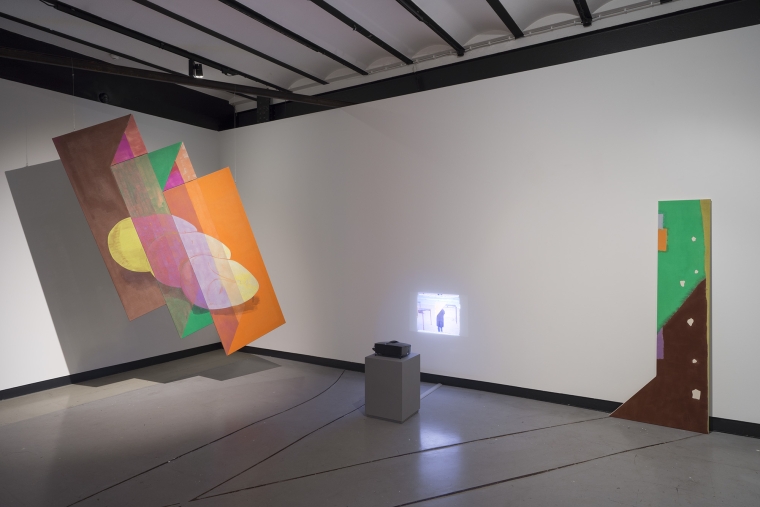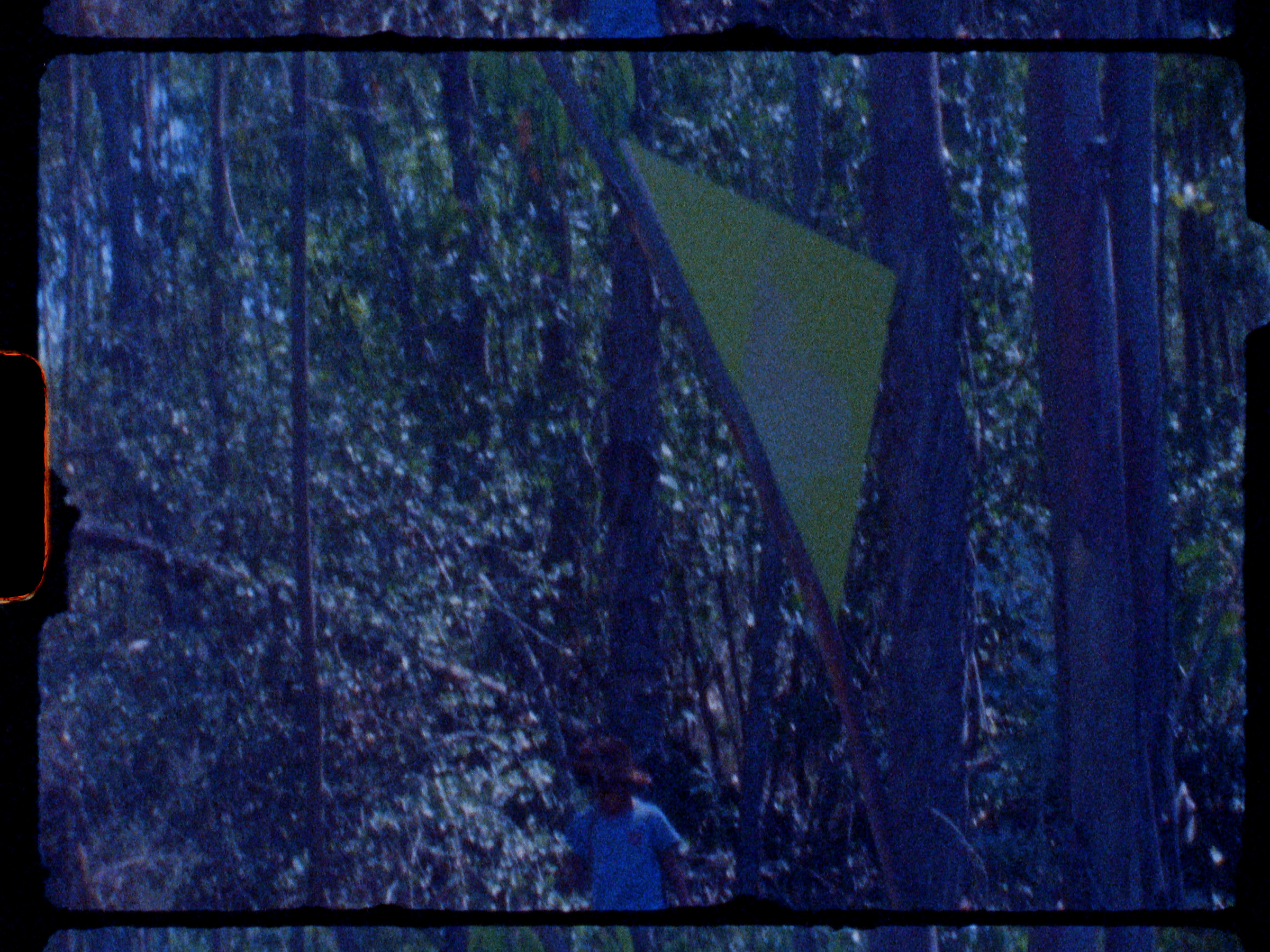
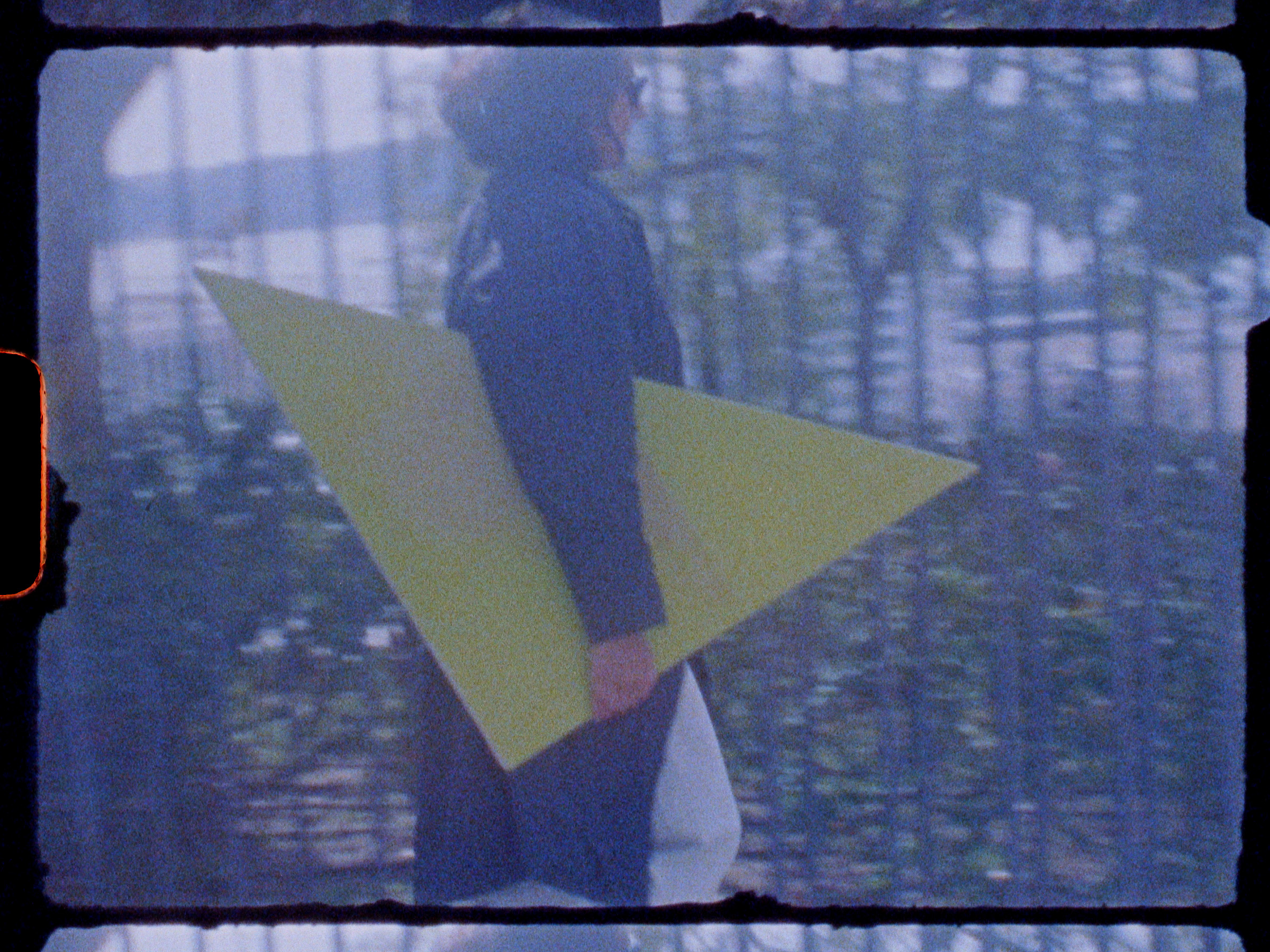
|
Film stills from Terra-Triangular, 2022–2023, by Ana Cardoso. Super 8 film transferred to digital video; 4 min 16 s. Music by Tim Pierson. |
|
Artist Ana Cardoso says of her maat show title, “Leaky Abstraction is a software development term [describing] an abstraction that cannot hide its concrete details.” The phrase is considered pejorative within the computer programming field: elements of raw data cannot be hidden, somehow causing systems to crash and programs to slow. I have known Cardoso for over a decade and find the problem of leaky abstraction important in relation to her work as an artist and to the current state of painting.
In her studio around 2011, Cardoso began to explore the possibilities of a language of stretched 44” square and triangular canvases which could be grouped and oriented in various ways and hung as modular units. At first, her focus was on gestalt shapes (squares, triangles) generated through the arrangement of a small group (two, four, eight) of paintings on a wall. Later, she would hang canvases in more elaborate configurations, creating flat trompe l’oeil geometries of folded recto and verso reminiscent of the illusionistic intricacies of Moroccan tilework. From the start, some of the panels were constructed from found fabrics. These knits and sheet patterns made into paintings presaged the problem of leaky abstraction: all-over composition still embarrassingly detailed. Pure form composed of tiny palm trees, or flowers, or balloons.
Cardoso’s occasional and thoughtful curatorial projects have similarly explored the imperfect and sometimes humorous relationship of abstract painting to everyday life. For example, in a performance during the opening for a 2010 summer group show Cardoso curated at the Brooklyn gallery Southfirst (which I co-founded and directed), participants repeatedly turned a flat, oblong object which emitted a rushing sound. Alison Knowles, the Fluxus founder, coached people to manipulate her large papier-mâché sculpture, which was filled with beans (hence the sound, like television static). Cardoso wrote about her multi-generational show in its press release, “[The exhibition title] Acts are for Actors refers to abstraction as a process or capacity that reveals an ongoing performance in every object, material form or diagram. An artist is an actor. The works in the show have in common the fact that their presence is revealed as a fact of material manipulation and time convergence. They are all residues of actions and meta-actions.” Cardoso’s selection of performative objects and thing-like paintings expressed her affinity with art objects which are loci of performance acts. These recalled the work of Guy de Cointet, in which, as Jay Sanders wrote, a “prop painting” functions to make the space around it a theatrical stage. (→ 1) (In New York, where Cardoso worked and painted over a decade, Jutta Koether’s performative uses of painting as stage or backdrop circa 2007–2008, most famously in her Lux Interior exhibition of 2009, had set new terms for painting. After 2009 in New York, to install a painting was to create a theatrical space of social interactions. Cardoso’s work has sharp eyes to Koether’s lessons and nuances: Painting beside itself, with one foot in the world and one foot in the gallery.) Along with Knowles’s sound-producing painting, Acts are for Actors included a younger generation of artists including the reflective canvases of Jacob Kassay, Anya Kielar’s shaped paintings (an eye, a nose), and a slideshow by Alexandre Singh, all Cardoso’s peers. In the stage of the show, Cardoso seemed to say, a painter is a role being played, not through language but through actions entered into with things. If a home in a Jacques Tati film had paintings, maybe they would have looked something like those Cardoso selected for her show. Shortly after Acts Are for Actors, Knowles was teaching viewers to make a sandwich in the Museum of Modern Art: bisecting cut bread squares into modernist rectangles and triangles fringed with lettuce and full of tuna fish, an effort that seemed to me harmonious with the inquiries about abstract art and the performance of everyday gestures that persist as a throughline in Cardoso’s work.
-
(1) Jay Sanders, “Mood Elevators and Changing Shapes,” Artforum, Summer 2007, pp. 416.
View of the exhibition Leaky Abstraction by Ana Cardoso (maat, 29/03–04/09/2023)) with the works Forma-Informa (2022, acrylic and oil on linen and cotton, 222 × 135 cm), Vinagre de ameixa yogurte de cabra leite de aveia (2022, acrylic and oil pastel on sewn cotton, 112 × 168 cm) and Estação Precipício (2021–2022, acrylic, oil and oil pastel on sewn linen, 232 × 60 cm). Photo: Nikolai Nekh, courtesy of EDP Foundation / maat.
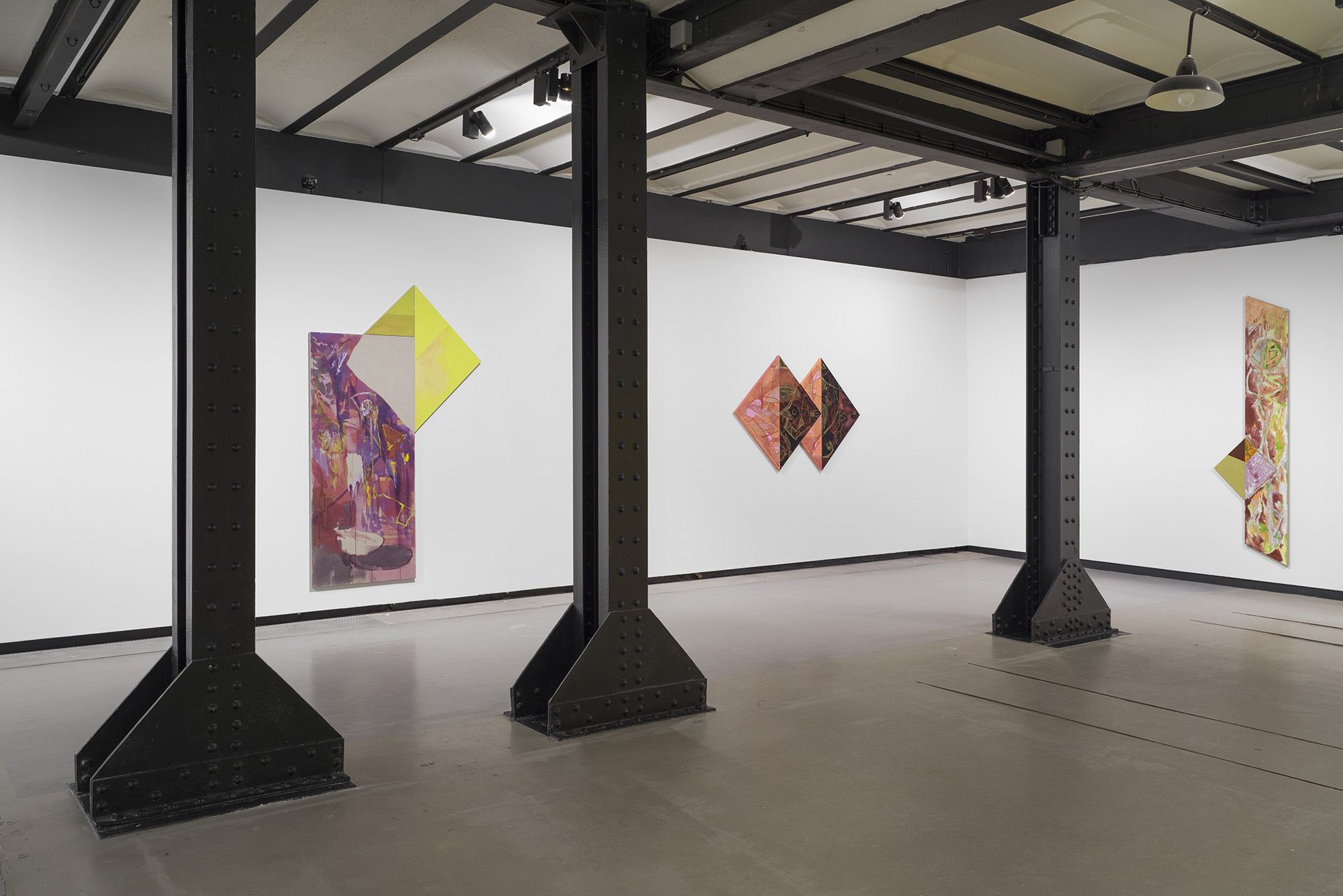
Alongside this New York interest in performance in relation to painting, Lygia Clark haunts Cardoso’s 2023 Leaky Abstraction exhibition: how might the universalist claims of geometric abstraction in general and Neo-concretism in particular walk off the canvas and into the viewer’s hands, to be used (drawn, cut, moved, ritualistically and phenomenologically); Nostalgia of the Body, as one Clark series title would have it. In the show, Cardoso’s explicit homage to a Clark painting, Vinagre de ameixa yogurte de cabra leite de aveia, 2022, is a supermarket list title for a geometric canvas that follows from Clark’s heretical dismissal of the hermetic divide between art and life. Cardoso brings together shopping list and studio, refusing the dichotomy modernism makes of the two realms: the domestic and the professional, the figurative and the abstract, the anecdotal and the universal. In Comer com as mãos, 2022 and Moléculas (Pterodactylus, Matisse, Etc), 2022–2023, Cardoso’s illusionistically folded strips of painting unfurl front and verso, a geometric game. Upon closer inspection, a child’s toy dinosaur, stenciled, plays Muybridge-like over the face of the latter painting’s panels like a plaything left out in a Poggenpohl kitchen.
View of the exhibition Leaky Abstraction by Ana Cardoso (maat, 29/03–04/09/2023) with the work Madrugada-Raiada (2022, acrylic on cotton, 172 × 192 cm). Photo: Nikolai Nekh, courtesy of EDP Foundation / maat.
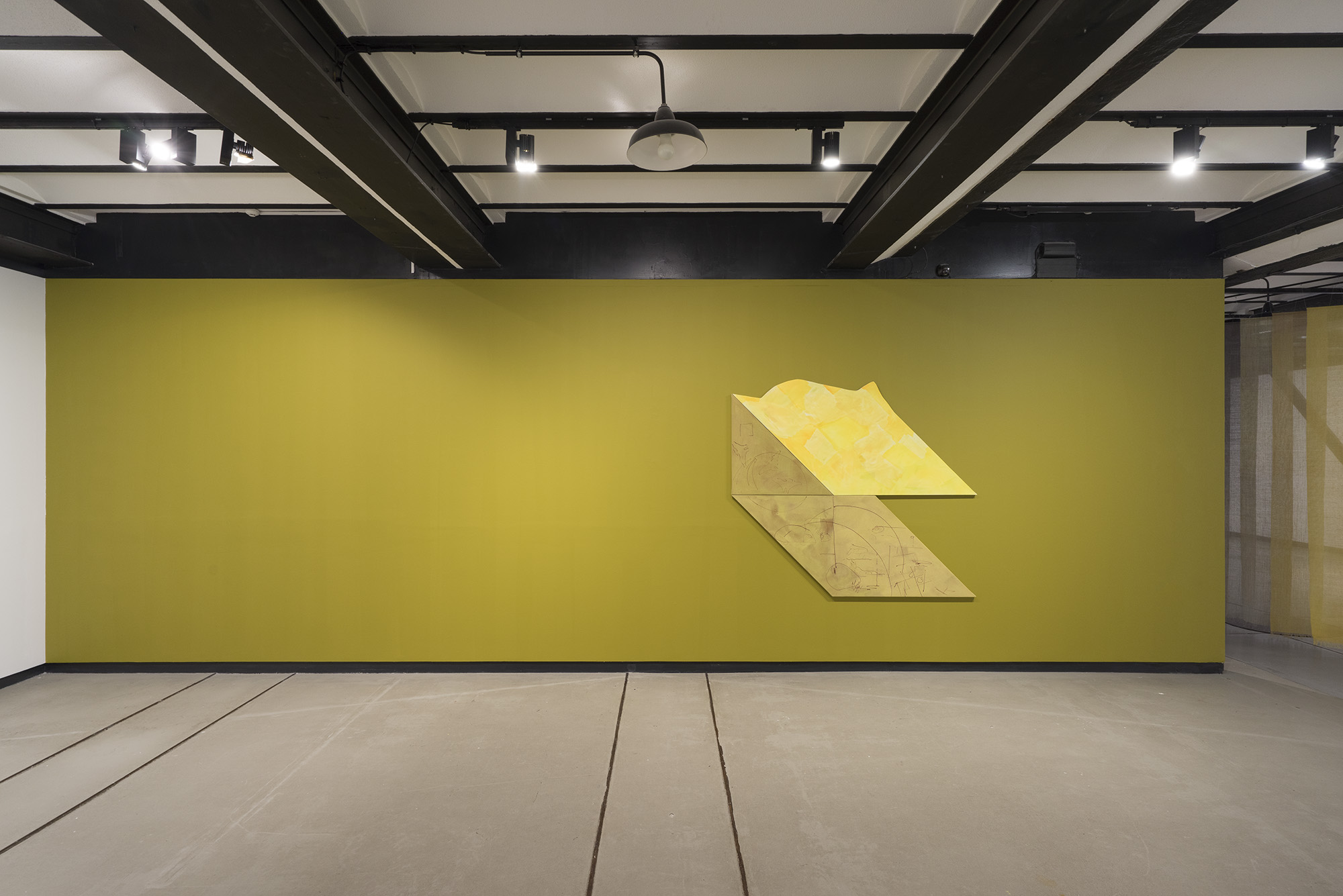
Madrugada-Raiada, 2022, is installed on a wall the same color as itself: a painting joke, an installation joke, and a color joke all at once, like a chameleon camouflaging itself against a wall. Cardoso’s paintings’ availability to be rearranged encourages participatory action alongside seeing, modernist modularity as performative action. Yet this performance is always attuned to the many ways in which the real puts pressure on the ideal: sometimes they are hung on walls of a too-similar color, sometimes they float a few feet from a wall, sometimes they reveal an embarrassing amount of information about the context in which they were created.
Cardoso has speculated that the medium of film could be a way to investigate and present the possible variations or permutations of actions on a set of modular canvases; for example, film could track the interchange of triangles and other shaped canvases as they move in the studio. This premise would follow from certain modernist uses of photography – Matisse, for example, photographing the permutations of certain paintings as they changed in the studio. In Cardoso’s film, Terra-Triangular, 2022–2023, she carries a large triangle painting – like a purse or perhaps like the Paßstück of Franz West, in which the cumbersome material object is part of a performative experience – around Lisbon accompanied by her young son, Adrian. To travel everywhere carrying a large, triangular canvas evokes a bit of Marcel Duchamp – his traveling sculpture, his boîte-en-valise. This film is ultimately about how art and life coexist – the yellow triangular paining appears in the trees, as Cardoso and her son walk down a country road. The boy participates in using the prop, seemingly without questions about this insertion of art into life, or life with art. The triangle finds echoes of its form in the straight line of a green door, and in the crux of a tree. Cardoso is stylish and perhaps even performative in her white jeans and trench coat; she looks like Dora Maar, or a little bit like Maya Deren, flipping between Cubist object and Surrealist author.
Her film made me think about motherhood, and mothers who are painters, in part because Cardoso is also visibly pregnant in the film: author of the film, subject of the film, producer of subjects in the film. Cardoso is constantly accompanied by both son and painting as she walks around Lisbon, but she is seemingly at ease. I think about the fraught way mother-painters of another generation described mothering. An interview with the painter R. H. Quaytman from 2015, around the time Cardoso and I were thinking about having children, comes to mind: “When the issue of motherhood comes up…Quaytman mostly talks about how it hurt her career. ‘I definitely don’t recommend it to my fellow female artists unless they just really, really want to do it,’ she said. Yet she insists she would have made the same kind of painting whether or not she had a child – an argument as compelling as it is strange.” (→ 2) In Terra-Triangular, motherhood and painting coexist: the Portuguese countryside is idyllic: the yellow triangle goes to the beach, it substitutes in for Cardoso’s face, her head, her body, it appears on the sand, in the city, with her son, seemingly without conflict. The music is a gentle John-Cage like avant-garde jangling. Here, the more radical propositions of modernist art and the numerous abstractions that comprise it become apparent: Can art remake the world? Can art help us imagine a world made new? Cardoso says of Tinturas (Natural Pigments), 2022, “I produced fabric for the show. I dyed linen threads with found natural elements: olive tree, citrus and fig tree leaves; cochineal, iron sulfite, copper.” This is an avant-garde attempt to strip painting back to its degree zero – a way to deconstruct painting stemming from Kazimir Malevich’s revolutionary Suprematist Composition: White on White, 1918. In Tinturas, painting is a product of the natural world, coaxed into being through labor (again the possible play on motherhood and painting). In these practices we spy a different historical and cultural “degree zero” of painting. Cardoso’s project is at its core utopian.
-
(2) Christine Smallwood, “The Mother-Daughter Thing,” March 24, 2015. The New York Times, T Magazine, https://archive.nytimes.com/tmagazine.blogs.nytimes.com/2015/03/24/susan-howe-rh-quaytman-mother-daughter-interview/ retrieved September 7, 2023.
Cardoso’s partner, artist Tim Pierson, writes in response, having read a draft to this stage: “About the notions of readymades, performativity, and women’s work: There is an interesting thing that happens with the specific objects of Judd, the ambient chance of Cage, and Duchamp's games. Effectively the move to concrete indexes, specificity, and deconstructions in the social field, respectively are all metonymical structures; such metonymies underwrite the coincidence of Lacan’s feminization and the quotidian ‘feminine’ tropes like dying, weaving etc. So metonymy ends up being a complex answer to the question ‘what do motherhood and abstraction have in common?’ That is to say, there is a structural parallel for the speaking subject between folding, dyeing; between the readymade, performance, and ‘women’s work.’”
In a textbook lineage of art history we might locate this use of the action as a readymade in the work of Yvonne Rainer (We Shall Run, 1963) and then Richard Serra (Verb List, 1967). What does it mean to engage in the specificity of gender within familiar verbs like “to run” or perhaps “to roll, to fold, to bend” or “to shave”? How is it that Serra’s folding could be seen as unmarked by gender, while Lygia Clark’s folding is a readymade gesture evocative of women’s work? What about “to dye” or “to labor”? If Cardoso lifts or carries, why are her gestures “leaky” and Serra’s gestures “found”?
From her modular paintings to her multigenerational curatorial practice and deep interest in painting as backdrop to performance, Cardoso has always existed in a world in which thinking about painting – from Malevich to Koether – is close to the skin of lived experience and yet unexpectedly not separate from thinking about folding laundry, or living with children, or eating a sandwich. For this reason, her work – which I would characterize as both utopian and radical – is important, and even vital. Cardoso’s painting is an act of resistance to the capitalist mechanization of life that demands that we separate our actions into discrete spheres: the productive, the leisured, the domestic, the public. In the notable collapse of public-private distinctions that marks the early 2020s – Zoom calls, home offices, performative Tik-Tok videos of intimate makeup rituals, Cardoso’s leaky abstraction also speaks deeply to our time.
How is it that Serra’s folding could be seen as unmarked by gender, while Lygia Clark’s folding is a readymade gesture evocative of women’s work?
Maika Pollack is an art historian and curator. She is currently Executive Director and Chief Curator of the Syracuse University Art Museum. She has curated exhibitions and published writing on artists including Rosemary Mayer, Ken Okiishi, Lois Lane, and Tetsuo Ochikubo.
Leaky Abstraction (maat, 29/03–04/09/2023), an exhibition by Ana Cardoso, is based on this artist’s research around the medium of painting. Exploring optical illusions allowed by the geometry of forms and a gestural and material based painting, Cardoso combines and simultaneously sabotages historical solutions of hard-edge and abstract painting with craft based practices: mixing or connecting dyed and hand-woven unpainted canvases with hand-painted industrial canvases, for instance. In her work, abstraction is grounded by a structure regulated by modular and geometric forms that are both independent and generic (although defined by the artist), – references to the history of abstraction, formalist strategies, etc. – as propositions for and of the body.


